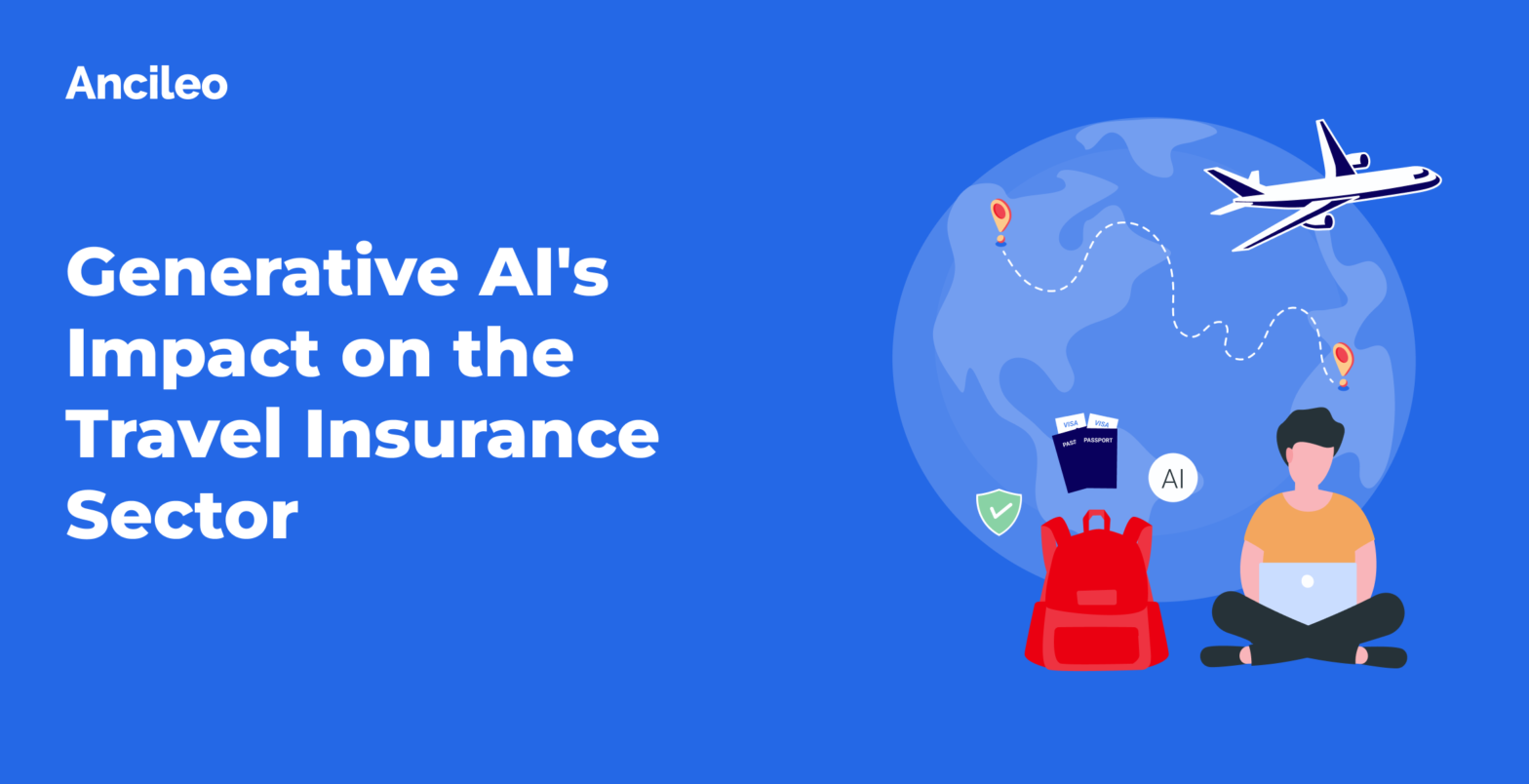
In today’s world, technology is making big waves everywhere, even in travel insurance. One of the most fantastic technologies making a splash is generative AI. Not familiar with the term? Well, it’s like a super-intelligent computer brain that can learn from lots of information and then create new stuff, like pictures or stories, all on its own!
But wait, why are we talking about generative AI in the travel insurance world? That’s because travel insurance companies are using it to do their job better. Travel insurance is all about keeping travelers safe and happy, and insurance generative AI can help them perform tasks more effectively with minimal effort. Travel insurance companies can use this fancy tech to determine risks, make better insurance plans, and even process claims faster.
Now, why does this matter? Well, these new technologies are changing how travel insurance works. With generative AI help, travel insurance companies can do things they couldn’t before, like better understanding risks, making custom plans for travelers, and ensuring claims get sorted out quickly and fairly. Let’s delve into more details on how generative AI impacts the travel sector!

Risk assessment in travel insurance used to be tough, with slow manual processes and difficulty in quickly analyzing significant amounts of data. But now, things are changing thanks to generative AI. This intelligent technology uses algorithms to look at lots of data quickly, predicting risks accurately and in real-time.
A few years ago, figuring out the risks in travel insurance was a slow process. This manual method took a long time, and sometimes, mistakes would slip through. It was like trying to solve a puzzle without all the right pieces, making it hard to get a clear picture of what might go wrong on a trip.
Imagine trying to keep track of everything happening simultaneously—it’s impossible! That’s what it felt like for travel insurance companies trying to analyze vast amounts of data in real-time. They couldn’t keep up with all the information coming in, like changes in weather, health alerts, or travel advisories. This meant they might miss important details that could affect travelers’ safety, leaving them vulnerable to risks that could have been avoided.
Generative AI in insurance is like having a super-smart friend who’s good at puzzles. It understands information and predicts what might happen next. With its advanced algorithms and predictive modeling, generative AI can look at all sorts of data, like past travel patterns or weather forecasts, and determine the chances of something going wrong on a trip. It helps travel insurance companies make better decisions about coverage and keep travelers safer.
Imagine having someone who can keep an eye on everything happening in the world and tell you about it immediately—that’s what generative AI insurance does with real-time data analysis. It looks at information as it comes in, like news updates or travel conditions, and quickly figures out how it might affect travelers. This means travel insurance companies can stay on top of things and adjust coverage or warn travelers about potential risks promptly. With generative AI’s real-time analysis, travelers can feel more confident knowing they get up-to-date travel protection.

Source: Revolutionizing Insurance Brokerage: The Versatile Applications of Generative AI | LinkedIn
Policy customization through insurance and generative AI is like having a personal tailor for travel insurance needs. Before, insurance plans were like trying to wear ill-fitting clothes, but now, thanks to generative AI, policies are tailored to fit just right. It listens to what you need and crafts a policy that matches your unique preferences and risks, whether for a specific destination, activity, or health condition.
Traditional one-size-fits-all insurance policies often fail to meet travelers’ diverse needs. These limitations highlighted the need for a more tailored approach to insurance. Travelers today expect coverage that matches their specific needs and preferences, whether it’s for certain destinations, activities, or health conditions. One-size-fits-all policies couldn’t keep up with this demand for customization, emphasizing the necessity for innovative solutions like insurance-generative AI to revolutionize policy customization in the travel insurance sector.
In today’s world, travelers want insurance coverage that feels like it’s made just for them. People expect insurance plans that match their unique needs and preferences. This demand for tailored coverage reflects a desire for peace of mind and assurance that their insurance will adequately protect their specific circumstances. Manually meeting this demand for personalized coverage poses significant challenges for insurance companies. Manual processes can be time-consuming and labor-intensive. It highlights the need for innovative solutions like generative AI to streamline the process and deliver personalized insurance experiences for travelers.
Generative AI for insurance is like having a personal assistant—it listens to each traveler’s unique story and adjusts their policy accordingly. By analyzing vast amounts of data, generative AI can identify individual risk profiles and dynamically adapt coverage options to fit. It’s like having a magic wand that can tweak policies in real-time based on changes in circumstances or preferences. This dynamic approach ensures that travelers receive the right level of protection explicitly tailored to their needs, giving them peace of mind throughout their journey.
Traditionally, underwriting involved time-consuming manual tasks and was prone to human errors, leading to inefficiencies and inaccuracies. However, the introduction of generative AI has revolutionized this landscape. Generative AI in insurance industry can accelerate decision-making, reduce operational costs, and improve the accuracy of risk assessments.
Traditional underwriting involves a lot of manual tasks that eat up time. Imagine a mountain of paperwork that needs to be filled out, reviewed, and processed by hand. Each step in the underwriting process requires human intervention. This manual handling slows down the entire process, causing delays in providing insurance coverage to customers.
Another challenge with traditional underwriting is the inherent risk of human error and inconsistencies. Despite the best efforts of underwriters, humans are fallible and prone to making mistakes. These errors and inconsistencies can have significant consequences, resulting in underwriting policies that provide inadequate coverage or overestimate risks, leading to higher customer premiums.
Generative AI insurance industry transforms underwriting by powerful machine learning algorithms to automate decision-making processes. Instead of relying solely on human judgment, generative AI analyzes vast data at incredible speeds. By learning from historical data and identifying patterns, generative AI and insurance can make predictions and assess risks with remarkable accuracy. This accelerated decision-making enables insurance companies to process applications swiftly, reducing the time it takes to provide coverage to policyholders.
Automating underwriting processes with insurance generative AI brings significant cost-saving benefits to insurance companies. By replacing time-consuming manual tasks with automated algorithms, insurers can streamline their operations and reduce the need for human resources. This reduction in labor costs translates into substantial savings for insurance companies, allowing them to allocate resources more efficiently. Moreover, the improved accuracy of underwriting decisions achieved through generative AI minimizes the risk of errors and inconsistencies.
Integrating generative AI into underwriting processes raises ethical concerns regarding fairness and bias mitigation. Machine learning algorithms can inadvertently perpetuate biases present in historical data, leading to discriminatory outcomes. To address this challenge, insurance companies must implement robust strategies to mitigate biases and ensure fairness in decision-making. It may involve carefully selecting and preprocessing training data to remove biases, regularly auditing AI models to detect and address potential biases, and incorporating fairness metrics into algorithm development.
Another challenge in implementing generative AI in underwriting is ensuring compliance with regulatory requirements and maintaining transparency in decision-making processes. Failure to comply with these regulations can result in legal repercussions and damage to the company’s reputation. To address this challenge, insurers must establish robust governance structures and compliance protocols to ensure that generative AI algorithms adhere to regulatory standards.

Source: How the customer experience influences the travel insurance market | ITIJ
Improving customer experiences in travel insurance is crucial. When travelers encounter issues like lost luggage or medical emergencies, waiting weeks or months for their claims to be processed can be frustrating and stressful. This delay not only affects their financial situation but also impacts their overall satisfaction with the insurance provider.
In the traditional insurance industry, a common challenge is the need for more communication and transparency throughout the claims process. Customers often feel left in the dark about the status of their claims, with little to no updates provided by the insurance company. This lack of transparency can leave customers feeling anxious and uncertain about the outcome of their claims, leading to frustration and dissatisfaction. As a result, customers may feel they need to be more valued, further eroding trust and loyalty towards the insurance company.
Generative AI plays a vital role in expediting claims processing, thereby enhancing customer experiences in travel insurance. It significantly reduces processing times by automating various aspects of the claims process, such as data entry, document verification, and decision-making. Travelers no longer have to endure lengthy waiting periods to receive reimbursement or assistance for their claims.
This acceleration in claims processing improves customer satisfaction and boosts confidence in the insurance provider’s ability to deliver on its promises. Generative AI also revolutionizes customer support in travel insurance by deploying chatbots and virtual assistants. These AI-driven tools enable real-time interaction and assistance, allowing customers to access support services whenever and wherever they need them.
While automation powered by generative AI can streamline processes and enhance efficiency, it is essential to pay attention to the importance of empathy and personalization in customer interactions. Travel insurance customers often seek understanding and support during stressful situations, such as filing a claim or dealing with emergencies abroad. Human touch, characterized by empathy and compassion, is crucial in addressing these emotional needs and building customer trust.
While generative AI offers valuable capabilities in automating routine tasks and providing real-time support, it should complement rather than replace human customer service. Human interactions bring warmth, understanding, and emotional intelligence that AI-driven systems may lack. For instance, AI-powered chatbots and virtual assistants can handle basic inquiries and routine tasks, freeing human agents to focus on complex issues and providing personalized assistance where empathy and emotional support are paramount.
Generative AI has revolutionized the travel insurance sector, bringing about significant advancements in various aspects of the industry. It has demonstrated its transformative potential, from streamlining underwriting processes to enhancing customer experiences. Generative AI has improved operational efficiency, accuracy, and customer satisfaction in travel insurance by automating tasks, accelerating decision-making, and providing real-time support.
Despite its numerous benefits, it is challenging to implement generative AI and insurance in travel insurance. Ethical considerations, bias mitigation, regulatory compliance, and transparency remain critical areas of concern. Insurance companies using generative AI must address these challenges responsibly to ensure generative AI’s fair, transparent, and ethical use. They can mitigate risks and build trust with customers and regulatory authorities by prioritizing responsible implementation practices.
Generative AI promises a more efficient, customer-centric future in travel insurance. With ongoing advancements in AI technology and continued refinement of algorithms, insurance companies can further improve their processes and offerings. By generative AI, insurers can create a future where travel insurance is more accessible, efficient, and tailored to individual needs.